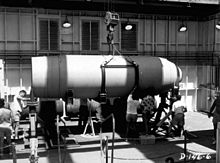
Nuclear weapon designs are physical, chemical, and engineering arrangements that cause the physics package of a nuclear weapon to detonate. There are three existing basic design types:

Operation Castle was a United States series of high-yield (high-energy) nuclear tests by Joint Task Force 7 (JTF-7) at Bikini Atoll beginning in March 1954. It followed Operation Upshot–Knothole and preceded Operation Teapot.

Castle Bravo was the first in a series of high-yield thermonuclear weapon design tests conducted by the United States at Bikini Atoll, Marshall Islands, as part of Operation Castle. Detonated on March 1, 1954, the device remains the most powerful nuclear device ever detonated by the United States and the first lithium deuteride-fueled thermonuclear weapon tested using the Teller-Ulam design. Castle Bravo's yield was 15 megatonnes of TNT (63 PJ), 2.5 times the predicted 6 megatonnes of TNT (25 PJ), due to unforeseen additional reactions involving lithium-7, which led to radioactive contamination in the surrounding area.

Ivy Mike was the codename given to the first full-scale test of a thermonuclear device, in which part of the explosive yield comes from nuclear fusion. Ivy Mike was detonated on November 1, 1952, by the United States on the island of Elugelab in Enewetak Atoll, in the now independent island nation of the Marshall Islands, as part of Operation Ivy. It was the first full test of the Teller–Ulam design, a staged fusion device.
Joe 4 was an American nickname for the first Soviet test of a thermonuclear weapon on August 12, 1953, that detonated with a force equivalent to 400 kilotons of TNT. The proper Soviet terminology for the warhead was RDS-6s, Reaktivnyi Dvigatel Specialnyi, lit. 'Special Jet Engine'.
RDS-37 was the Soviet Union's first two-stage hydrogen bomb, first tested on 22 November 1955. The weapon had a nominal yield of approximately 3 megatons. It was scaled down to 1.6 megatons for the live test.

A boosted fission weapon usually refers to a type of nuclear bomb that uses a small amount of fusion fuel to increase the rate, and thus yield, of a fission reaction. The neutrons released by the fusion reactions add to the neutrons released due to fission, allowing for more neutron-induced fission reactions to take place. The rate of fission is thereby greatly increased such that much more of the fissile material is able to undergo fission before the core explosively disassembles. The fusion process itself adds only a small amount of energy to the process, perhaps 1%.

Castle Yankee was the code name given to one of the tests in the Operation Castle series of American tests of thermonuclear bombs. It was originally intended as a test of a TX-16/EC-16 Jughead bomb, but the design became obsolete after the Castle Bravo test was successful. The test device was replaced with a TX-24/EC-24 Runt II bomb which was detonated on May 5, 1954, at Bikini Atoll. It released energy equivalent to 13.5 megatons of TNT, the second-largest yield ever in a U.S. fusion weapon test.
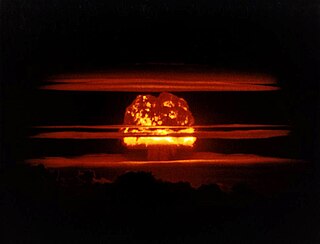
Castle Union was the code name given to one of the tests in the Operation Castle series of United States nuclear tests. It was the first test of the TX-14 thermonuclear weapon, one of the first deployed U.S. thermonuclear bombs.

A thermonuclear weapon, fusion weapon or hydrogen bomb is a second-generation nuclear weapon design. Its greater sophistication affords it vastly greater destructive power than first-generation nuclear bombs, a more compact size, a lower mass, or a combination of these benefits. Characteristics of nuclear fusion reactions make possible the use of non-fissile depleted uranium as the weapon's main fuel, thus allowing more efficient use of scarce fissile material such as uranium-235 or plutonium-239. The first full-scale thermonuclear test was carried out by the United States in 1952; the concept has since been employed by most of the world's nuclear powers in the design of their weapons.
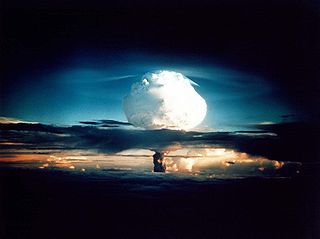
The Teller–Ulam design is a technical concept behind modern thermonuclear weapons, also known as hydrogen bombs. The design – the details of which are military secrets and known to only a handful of major nations – is believed to be used in virtually all modern nuclear weapons that make up the arsenals of the major nuclear powers.
The B46 nuclear bomb was an American high-yield thermonuclear bomb which was designed and tested in the late 1950s. It was never deployed. Though originally intended to be a production design, the B46 ended up being only an intermediate prototype of the B-53 and was test fired several times. These prototypes were known as TX-46 units (Test/Experimental).

The Mark 24 nuclear bomb was an American thermonuclear bomb design, based on the third American thermonuclear bomb test, Castle Yankee. The Mark 24 bomb was tied as the largest weight and size nuclear bomb ever deployed by the United States, with the same size and weight as the Mark 17 nuclear bomb which used a very similar design concept but unenriched Lithium.

Canopus was the codename of the first French two-stage thermonuclear test. It was conducted by the Pacific Carrier Battle Group on 24 August 1968, at the Pacific Experiments Centre near Fangataufa atoll, French Polynesia. The test made France the fifth country to test a thermonuclear device after the United States, the Soviet Union, the United Kingdom and China.
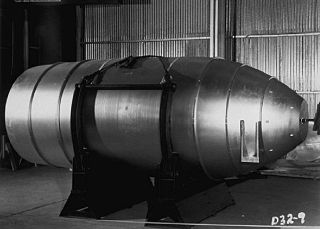
The Mark 14 nuclear bomb was a 1950s strategic thermonuclear weapon, the first deployed solid-fuel hydrogen bomb. It was an experimental design, and only five units were produced in early 1954. It was tested in April 1954 during the Castle Union nuclear test and had a yield of 6.9 Mt. The bomb is often listed as the TX-14 or EC-14. It has also been referred to as the "Alarm Clock" device though it has nothing to do with the design by the same name proposed earlier by Edward Teller and known as the Sloika in the Soviet Union.
The Mark 16 nuclear bomb was a large thermonuclear bomb, based on the design of the Ivy Mike, the first thermonuclear device ever test fired. The Mark 16 is more properly designated TX-16/EC-16 as it only existed in Experimental/Emergency Capability (EC) versions.

The Mark 21 nuclear bomb was a United States thermonuclear gravity bomb first produced in 1955. It was based on the TX 21 "Shrimp" prototype that had been detonated during the Castle Bravo test in March 1954. While most of the Operation Castle tests were intended to evaluate weapons intended for immediate stockpile, or which were already available for use as part of the Emergency Capability Program, Castle Bravo was intended to test a design which would drastically reduce the size and costs of the first generation of air-droppable atomic weapons.

The uranium hydride bomb was a variant design of the atomic bomb first suggested by Robert Oppenheimer in 1939 and advocated and tested by Edward Teller. It used deuterium, an isotope of hydrogen, as a neutron moderator in a uranium-deuterium ceramic compact. Unlike all other fission-based weapon types, the concept relies on a chain reaction of slow nuclear fission. Bomb efficiency was adversely affected by the cooling of neutrons since the latter delays the reaction, as delineated by Rob Serber in his 1992 extension of the original Los Alamos Primer.
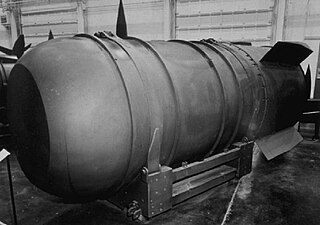
The Mk 36 was a heavy high-yield nuclear bomb designed in the 1950s. It was a thermonuclear, using a multi-stage fusion secondary system to generate yields up to about 10 megatons TNT equivalent.

The British hydrogen bomb programme was the ultimately successful British effort to develop hydrogen bombs between 1952 and 1958. During the early part of the Second World War, Britain had a nuclear weapons project, codenamed Tube Alloys. At the Quebec Conference in August 1943, British prime minister Winston Churchill and United States president Franklin Roosevelt signed the Quebec Agreement, merging Tube Alloys into the American Manhattan Project, in which many of Britain's top scientists participated. The British government trusted that America would share nuclear technology, which it considered to be a joint discovery, but the United States Atomic Energy Act of 1946 ended technical cooperation. Fearing a resurgence of American isolationism, and the loss of Britain's great power status, the British government resumed its own development effort, which was codenamed "High Explosive Research".

